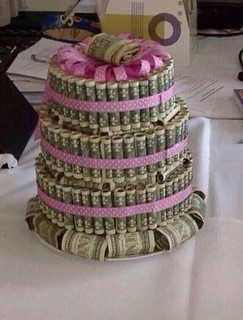
About UsThe Numismatic Bibliomania Society is a non-profit organization promoting numismatic literature. For more information please see our web site at coinbooks.org SubscriptionsThose wishing to become new E-Sylum subscribers (or wishing to Unsubscribe) can go to the following web page link MembershipThere is a membership application available on the web site Membership Application To join, print the application and return it with your check to the address printed on the application. Membership is only $15 to addresses in the U.S., $20 for First Class mail, and $25 elsewhere. For those without web access, write to: David M. Sundman, Treasurer AsylumFor Asylum mailing address changes and other membership questions, contact David at this email address: dsundman@LittletonCoin.com SubmissionsTo submit items for publication in The E-Sylum, just Reply to this message, or write to the Editor at this address: whomren@gmail.com
BUY THE BOOK BEFORE THE COIN |
- WAYNE'S WORDS: THE E-SYLUM OCTOBER 13, 2013
- CHARLES DAVIS NOVEMBER 16, 2013 SALE CATALOG AVAILABLE
- NEW BOOK: A GUIDE BOOK OF CIVIL WAR TOKENS
- NEW BOOK: SYLLOGE NUMMORUM GRAECORUM GREECE 7
- NEW BOOK: AMERICAN NUMISMATIC AUCTIONS TO 1875 AVAILABLE
- THE FROST SHIPS AND SHIPWRECKS SHELVES AT THE ANS LIBRARY
- ANS LIBRARY WISH LIST UPDATED
- 2014 CENTRAL STATES AUTHOR GRANTS ANNOUNCED
- NOTES FROM E-SYLUM READERS: OCTOBER 13, 2013
- MORE ON NUMISMATIC INDEXES
- NORTH CAROLINA ORGANIZATION HOPES TO BUY BECHTLER HOUSE
- ARTICLE PROFILES VICTORIA CROSS COLLECTOR LORD ASHROFT
- CHILD COAL-MINE HERO'S RSPCA MEDAL TO BE SOLD
- IS A PHD MANDATORY FOR NUMISMATIC CURATORS?
- MORE QUESTIONS ON THE COIN COLLECTORS KLINE
- BLOG PROFILES COIN DESIGNER CHISTOPHER IRONSIDE
- BLACKFRIARS BRIDGE AND HOLBORN VIADUCT MEDAL
- 1604 HENRY IIII MEDAL INFORMATION SOUGHT
- SILVERDALE VIKING COIN HOARD TO BE DISPLAYED
- QUERY: INFORMATION ON FLUSSGOLDDUKATEN SOUGHT
- THE USE OF CHINESE COINS IN BALI
- BANK OF CEYLON PLANS NEW MUSEUM IN 2014
- PRINCE GEORGE'S £50,000 GOLD COIN
- VATICAN MEDAL MISSPELLS NAME OF JESUS
- BEP RELEASES NEW 2013 $100 BILL
- BANK OF ENGLAND'S BANKNOTE DESIGN DECISION PROCESS REVEALED
- A BIRTHDAY CAKE MADE OF DOLLARS
- ARTISTS FORMS GEOMETRIC SCULPTURES FROM INTERLOCKED COINS
- FEATURED WEB PAGE: VISIT N.C .GOLD
Click here to access the complete archive
To comment or submit articles, reply to whomren@gmail.com
WAYNE'S WORDS: THE E-SYLUM OCTOBER 13, 2013

New subscribers this week include Lou Sutton and William Roberson. Welcome aboard! We have 1,676 email subscribers, plus 247 followers on Facebook.
Time didn't allow me to get everyone's contributions into this week's newsletter, nor did I manage to write up a Numismatic Diary or book review. Sorry, folks, but some of these will roll over into subsequent issues. Still, we've got a jam-packed issue this week with interesting topics from all over. And I got to watch my middle son solve Rubik's Cube over and over all morning and play restaurant with my daughter all afternoon and see my eldest son's basketball game this evening.
We open with a note from Charlie Davis on his upcoming numismatic literature sale, and information on three new books. Next up are notes on the American Numismatic Society library. Other topics include the Bechtler House, numismatic indexes, and Victoria Cross and RSPCA medals.
To learn more about Gordon Frost's Seawall, F. J. Klein, Jean Ironside's Britannia pose, Chinese coins in Bali, the cake made of dollars, and flussgolddukaten, read on. Have a great week, everyone!
Wayne Homren
Editor, The E-Sylum
CHARLES DAVIS NOVEMBER 16, 2013 SALE CATALOG AVAILABLE
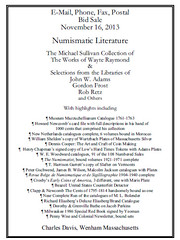 I have posted our current sale of numismatic literature on www.numisbook.com Click on the notice on the upper right left for the catalogue. Follow the link to www.charlesdavisnumismatics.com for photographs of many of the lots. Currently over 200 are posted and we will be adding more daily. A photo of any specific lot will be posted on request. The closing date is the Saturday after Whitman Baltimore/C4 and we will have a number of the lots there available for preview.
I have posted our current sale of numismatic literature on www.numisbook.com Click on the notice on the upper right left for the catalogue. Follow the link to www.charlesdavisnumismatics.com for photographs of many of the lots. Currently over 200 are posted and we will be adding more daily. A photo of any specific lot will be posted on request. The closing date is the Saturday after Whitman Baltimore/C4 and we will have a number of the lots there available for preview.
Charles Davis
P.O. Box 547
Wenham, MA 01984
Tel: (978) 468 2933
Fax: (978) 468 7893
http://www.numisbook.com
To view the complete sale, see: www.charlesdavisnumismatics.com/numis_images/SaleNov16.pdf
To read the earlier E-Sylum article, see: CHARLES DAVIS MAIL BID SALE CLOSES NOVEMBER 16, 2013 (www.coinbooks.org/esylum_v16n40a02.html)
NEW BOOK: A GUIDE BOOK OF CIVIL WAR TOKENS
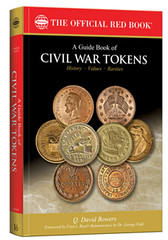 Whitman Publishing announces the release of A Guide Book of Civil War Tokens, by Q. David Bowers. The 448-page book debuted at the American Numismatic Association World’s Fair of Money in Chicago, August 13, 2013. Bowers autographed copies at the Whitman Publishing booth and presented the book at the Civil War Token Society meeting on August 15. A Guide Book of Civil War Tokens is now available online (including at www.Whitman.com) and from bookstores and hobby shops nationwide. Its retail price is $24.95.
Whitman Publishing announces the release of A Guide Book of Civil War Tokens, by Q. David Bowers. The 448-page book debuted at the American Numismatic Association World’s Fair of Money in Chicago, August 13, 2013. Bowers autographed copies at the Whitman Publishing booth and presented the book at the Civil War Token Society meeting on August 15. A Guide Book of Civil War Tokens is now available online (including at www.Whitman.com) and from bookstores and hobby shops nationwide. Its retail price is $24.95.
Civil War tokens are small cent–sized tokens, mostly of copper or brass, that were issued by private firms to serve as emergency “money” during the small-change shortage of 1862 to 1865. As the military conflict dragged on, Americans hoarded any gold, silver, and eventually even copper U.S. coins they received in change, keeping them as hedges against wartime economic uncertainty. Civil War tokens, privately issued by hundreds of merchants and organizations and minted in the millions, were used as substitutes for hoarded “pennies” to make change for small purchases. Today these tokens are highly collectible, with values generally ranging from $15 for common, circulated pieces to more than $15,000 for rarities.
Bowers, widely regarded as the “Dean of American Numismatics,” wrote A Guide Book of Civil War Tokens with the cooperation of the Civil War Token Society, the American Numismatic Society, the Token and Medal Society, the American Numismatic Association, and other leading organizations, museums, libraries, collectors, dealers, and researchers. The book includes more than 2,000 full-color images, plus values in multiple grades, rarity ratings, detailed historical background, a study of how Civil War tokens were manufactured, ways to collect them, identification of unusual varieties, and information on the potential for valuable new discoveries. It covers both patriotic tokens and “store cards” (merchant advertising tokens). Much of the information has never been published in book form. Nearly every known die is described in both pictures and text.
“The Guide Book of Civil War Tokens is a unique reference,” said Whitman publisher Dennis Tucker. “It is the only modern price guide to Civil War tokens on the market today. The cover price of $24.95 is about what a single average copper token costs in Very Fine condition. With that small investment a reader will become an expert on Civil War tokens.” Speaking at a “Money Talks” presentation with Bowers at the ANA 2013 World’s Fair of Money, Tucker called the book “absolutely essential for dealers, collectors, and appraisers.”
“No book on how to collect Civil War tokens has ever been as thorough,” said Dr. George Fuld, a published expert in the field. “I expect that it will be a standard reference for years to come.” Fred Reed, another expert on Civil War money and editor of the Token and Medal Society Journal, said, “Every collector of this series will esteem this volume, and every historian or serious writer on the Civil War should consult its colorful pages in the future.”
A Guide Book of Civil War Tokens
Volume 16 in the Bowers Series
By Q. David Bowers
Foreword by Fred L. Reed
Reminiscence by Dr. George Fuld
ISBN 0794824536
448 pages
6 x 9 inches, softcover
Full color
Retail $24.95
NEW BOOK: SYLLOGE NUMMORUM GRAECORUM GREECE 7
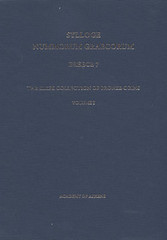 Sylloge Nummorum Graecorum Greece 7, The KIKPE Collection of Bronze Coins
by Vasiliki Penna & Yannis Stoyas
(Research Centre for Antiquity of the Academy of Athens, 2012)
Sylloge Nummorum Graecorum Greece 7, The KIKPE Collection of Bronze Coins
by Vasiliki Penna & Yannis Stoyas
(Research Centre for Antiquity of the Academy of Athens, 2012)
Hardcover, 291 pp
Indices: Issuing Authorities - Georgraphical Terms, Issuing Authorities - Historical Persons
This volume contains descriptions and excellent photographs of 1,233 bronze coins from Spain to India, the Black Sea to Africa, which date from the fifth century to c. 27-25 BCE.
ISSN 1790-0069
ISBN 978-060-404-242-5
A review by Dr. Ute Wartenberg Kagan will appear in the ANS Magazine issue 2013 no. 3
To read the complete article, see: Sylloge Nummorum Graecorum Greece 7, The KIKPE Collection of Bronze Coins (numismatics.org/Store/SNGGr7KIKPE)
NEW BOOK: AMERICAN NUMISMATIC AUCTIONS TO 1875 AVAILABLE
A Documentary History of American Numismatics : Chronicling American Numismatic History
This is a multi volume series designed by John N. Lupia as the American counterpart of the Encyclopedia of British Numismatics.
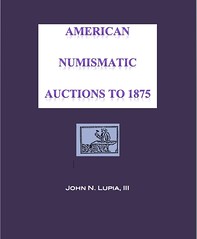 Volume 1 : American Numismatic Auctions To 1875 : A Chronicle of American Numismatic History.© ISBN: 978-0-9826739-1-1
Volume 1 : American Numismatic Auctions To 1875 : A Chronicle of American Numismatic History.© ISBN: 978-0-9826739-1-1
A solid Introduction provides a substantial setting into which is placed the history of American numismatic sales. Well over 700 entries with more than 200 numismatic auction sales "Not in Attinelli" more than 400 pages of numismatic auctions listed from the earliest period in American history to the end of 1875.
The entries are American numismatic auctions both coins, medals and numismatic literature, and salient information on the history of American numismatics and collecting in America from its beginning to the end of 1875 -- following the time-frame established by Attinelli.
The book includes the first part of Attinelli but expanded and enlarged to incorporate the myriad of new entries. Also, the three numbering systems in the book do not tally as Attinelli since he had multiple entries for the same auction in many cases, which are now combined into their respective auction entry. So although Attinelli could claim more than 400 auction entries that number is reduced in this new revised expanded and enlarged edition.
Each entry is annotated with commentary and bibliographic references, some illustrated. The three numbering systems are (1) chronicling American numismatic history and the history of collecting in America, (2) coin auctions, (3) numismatic auctions. An additional numbering system monitors what is not in Attinelli and what is in Attinelli.
An indispensable reference tool for scholars and researchers especially for catalogers and those researching provenance of various specimens and numismatic literature.
ISBN: 978-0-9826739-1-1
Regina Caeli Press
8.5" x 11"
Paperback
400 pages
October 2013
$165.00 + S&H
First printing is a short run of 100 copies. If the market so demands a second printing will ensue after the first printing is exhausted.
For more information, see: A Documentary History of American Numismatics Series (https://sites.google.com/site/numismaticmallcom/american-numismatic-history)
To read the earlier E-Sylum article, see: NEW BOOK: AMERICAN NUMISMATIC AUCTIONS TO 1875 (www.coinbooks.org/esylum_v16n30a04.html)

THE FROST SHIPS AND SHIPWRECKS SHELVES AT THE ANS LIBRARY
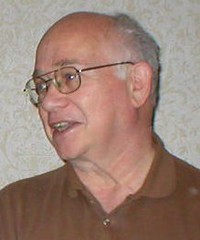 I was doing some research in the American Numismatic Society Library the other week and I came across the shelves of books on ships and shipwrecks dedicated to the memory of F. Gordon Frost, with many of the books donated from his collection (not all - I think the book about Homer's Catalog of Ships was already in the ANS Library).
I was doing some research in the American Numismatic Society Library the other week and I came across the shelves of books on ships and shipwrecks dedicated to the memory of F. Gordon Frost, with many of the books donated from his collection (not all - I think the book about Homer's Catalog of Ships was already in the ANS Library).
The shelves look so attractive that I asked ANS Librarian Elizabeth Hahn if she could send me photographs of the shelves, which she very kindly did. The photographs are excellent - one of them I was able to enlarge enough to read most of the titles so I could virtually "browse" the shelves. I sure wish my library looked this good.
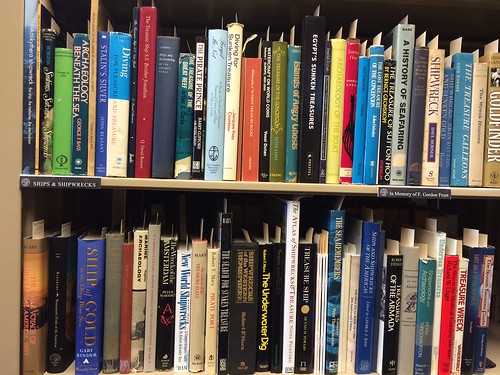
When working through Gordon's books, I sorted out the maritime titles into a separate area, all alphabetized by author's last name, that Rosalie Frost dubbed "The Seawall" - it filled about nine bookcases. John Huffman (who, like Gordon, left us all too soon) and I went through the Seawall and compared it with the ANS online catalog and chose books to donate that the ANS didn't already have (the ANS has such an incredible library that it is hard to find books they don't have).
John Huffman himself was a very advanced collector of books in this area - when he retired from the IRS his co-workers gave him a pirate-themed farewell party (they are a lot more fun-loving in the IRS than you might expect!). He knew more about the books in this area than I do, but when I added volume 57 of Transactions of the American Philosophical Society to the pile of books for the ANS and John Huffman didn't know what it was, I was proudly able to tell him that it was George Bass's final report about the Cape Gelidonya shipwreck and we definitely wanted to give ANS that.
Gordon hated using the term "rare" in regard to books, but I am more sloppy in this respect, and Bass's report about Cape Gelidonya fits my definition of rare, viz. I wasn't able to find it in the collection of the New York Public Library.
To read the earlier E-Sylum article, see: GORDON FROST 1935 - 2011 (www.coinbooks.org/esylum_v14n10a02.html)
ANS LIBRARY WISH LIST UPDATED
There are so many books and periodicals that belong in the Harry W. Bass, Jr. Library but our budget is not always able to satisfy our needs. If you have an extra copy of any of the following items, or wish to purchase a copy for us, it would be much appreciated! Book donations should be directed to the following mailing address:
American Numismatic Society
Attn: Librarian
75 Varick Street, Floor 11
New York, NY 10013
U.S.A.
Auction Catalog Wish List:
The ANS Library has a number of gaps in the auction catalogs and periodicals sections. Please inquire for details.
Books Wish List: Books are listed in no particular order.
-- Alessandro Toffanin. 2013. Numismatica Varesi. Monete Italiane Regionale (MIR) series. MILANO. More details on the Varesi website.
-- Bill Bugert; Rand Wiley. 2011. A Register of Seated Half Dollar Varieties Volume III -- New Orleans Branch Mint 1840-O to 1853-O (No Arrows).
-- ATTI DEL 3° CONGRESSO DI NUMISMATICA. Bari 12-13 Novembre 2010. La monetazione pugliese dall'età classica al medioevo (III). La monetazione della Messapia. La monetazione angioina nel Regno di Napoli. Ed. 2011, f.to 18x26cm., pp. 602, ill. b/n e a colori.
-- ATTI DEL 2° CONGRESSO NAZIONALE DI NUMISMATICA. Bari 13-14 Novembre 2009. La monetazione pugliese dall'età classica al medioevo (2). Le monete della Peucezia. La monetazione sveva nel regno di Sicilia. Ed. 2010, f.to 18x26cm., pp. 414, ill. b/n e a colori.
-- ATTI DEL 1° CONGRESSO DI NUMISMATICA. Bari 21-22 Novembre 2008. La monetazione pugliese dall'età classica al medioevo (I). La monetazione della Daunia. Le monete Normanne dell'Italia Meridionale. Ed. 2009, f.to 18x26cm., pp. 302, ill. b/n e a colori.
-- JUVENILIA. Raccolta degli scritti presentati al Concorso per giovani numismatici "Nino Rapetti" 2011. Ed. 2011, f.to 17x24cm., pp. 192, ill. b/n.
-- (a cura di Antonio Morello). KAMPANOS. Ed. 2010, f.to 17x24cm., pp. 176, ill. b/n.
-- EOS. Collana di studi numismatici. IV. Circolo Numismatico Pugliese. Ed. 2012, f.to 18x26cm., pp. 374, ill. b/n e a colori.
-- Alberto D'Andrea - Vincenzo Contreras. LE MONETE DELLE ZECCHE MINORI DELLA CAMPANIA. Vol. III - SALERNO. Ed. 2012, f.to 15x21cm., pp. 328+15 tav a col., ill. b/n, brossura.
-- Alberto D'Andrea - Gaetano Faranda - Elena Vichi. LE MONETE SICILIANE DAI BIZANTINI AGLI ARABI. Ed. 2012, f.to 15x21cm., pp. 842 + pp 40 a colori + 24 pagine di prezziario.
-- Alberto D'Andrea, Christian Andreani, Simonluca Perfetto LE MONETE NAPOLETANE DA FILIPPO II A CARLO VI. Ed. 2010, f.to 15x21cm., pp. 512, ill. b/n + 48 pp. a colori + 8 pp prezziario.
-- Gianluigi Esposito NOTE SUI "LUIGINI" DI MASSA DI LUNIGIANA Tentativo di elenco delle monete da 8 bolognini di Alberico II Cybo. Ed. 2012, f.to 17x24cm., pp. 144, ill. b/n.
-- Alberto Trivero Rivera GIUSTA GRATA ONORIA è il mio nome. Ed. 2012, f.to 17x24cm., pp. 144, ill. b/n.
-- The Chips and Coupons in Old Shanghai, Tokens (2005). Editor: Pan Junxiang. Publisher: Shanghai Academy of Social Science, edited and printed in Shanghai in 2005. 279 pages. This book has nearly all local tokens, chips, coupons and tokens banknotes issued during AD 1860's to 1950's. Cited in the Esylum.
To read the complete article, see: Wish List for the ANS Library (numismatics.org/Library/WishList)
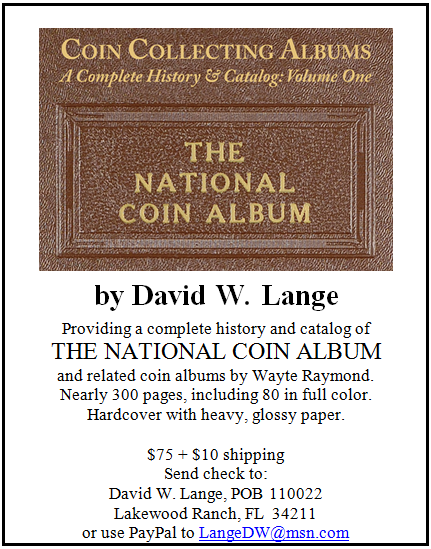
2014 CENTRAL STATES AUTHOR GRANTS ANNOUNCED
The following author grants were approved by the Central States Board at their Fall Board meeting in Louisville, KY.
Ron Abler - "Centennial Medals of 1876"
Scott Blickensderfer - "Indiana Civil War Store Cards Catalogue"
Roger Burdette - "Journal of Numismatic Research" Articles
Paul Cunningham - "Abraham Lincoln's Metallic Legacy"
Ray & Steve Feller - "Civilian Camp Monies of WW II Catalogue"
Mark Ferguson - "The Dollar of 1804 - The U.S. Mint's Hidden Secret"
Peter Huntoon - "Dated Back National Banknotes"
TAMS - Q. David Bowers - U.S. Shell Cards - 1864-1880"
For information on applying for a grant applications for 2015 see: centralstates.info/grants.html
or contact
W. Ray Lockwood
Marion, Indiana 46952
Ph. 765-664-6520
Email: sunrayofmarion@aol.com
NOTES FROM E-SYLUM READERS: OCTOBER 13, 2013
CANADIAN CENT OVERSTRIKE: ERROR OR FAKE?
Tom DeLorey writes:
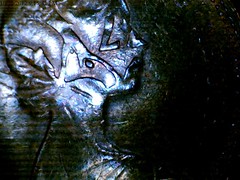 I would like to respectfully suggest that new member Petr Mares have his 1977 Canadian cent error professionally authenticated. Although I cannot tell for sure from the photographs, there exists a strong possibility that the second strike was applied outside the Royal Canadian Mint using false dies.
I would like to respectfully suggest that new member Petr Mares have his 1977 Canadian cent error professionally authenticated. Although I cannot tell for sure from the photographs, there exists a strong possibility that the second strike was applied outside the Royal Canadian Mint using false dies.
To read the earlier E-Sylum article, see: A CANADIAN CENT OVERSTRIKE ERROR (www.coinbooks.org/esylum_v16n41a13.html)
More Tokens With Images of Books
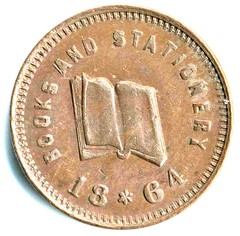 Dennis Tucker of Whitman Publishing writes:
Dennis Tucker of Whitman Publishing writes:
There are several Civil War store-card token dies that feature books. The ones attached are all pictured in Dave Bowers’s newest reference, the 448-page Guide Book of Civil War Tokens.
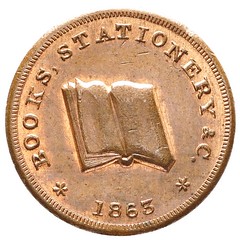
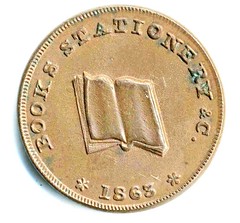
To read the earlier E-Sylum article, see: COINS, TOKENS AND MEDALS WITH IMAGES OF BOOKS (www.coinbooks.org/esylum_v16n41a15.html)
THE BOOK BAZARRE
MORE ON NUMISMATIC INDEXES
David Gladfelter writes:
I thought the place to go would be the Canadian Numismatic Bibliography published six years ago by the Numismatic Education Society of Canada, edited by Darryl Atchison. But there are only six entries under Serge Pelletier’s name. The ANS Numismatic Literature might have more, but it is difficult to search. You have to go year by year.
Jon Radel writes:
Elizabeth Hahn may beat me in pointing this out, but the library catalog at the ANS is worth checking in cases such as this....
Canadian trade dollars / by Remick, Jerry; Pelletier Serge World Coin News Vol 6, no 18 (May 1, 1979) p. 20-26
comes up, among a variety of other articles.
American Numismatic Society Librarian Elizabeth Hahn writes: writes:
I saw the note in this week's E-Sylum that Serge Pelletier was trying to find a listing of articles he had written over time. I was surprised to see that no one tried the ANS Library catalog, DONUM! We actively index articles and have done so for decades so we have over 100,000 entries for articles alone. A search for Serge Pelletier brought back the following books and articles:
donum.numismatics.org/cgi-bin/koha/opac-search.pl?idx=kw&q=Pelletier%20&limit=au:Pelletier,%20Serge .
As I've noted before, we do actively index all major numismatic publications, including Coin World, Numismatic News, occasionally World Coin News, and so many others. You can even do an advanced search to look for only articles before a certain date, such as 2004:
donum.numismatics.org/cgi-bin/koha/opac-search.pl
which brings back 16 results:
To read the earlier E-Sylum article, see: QUERY: INDEX FOR NUMISMATIC NEWS, WORLD COIN NEWS SOUGHT (www.coinbooks.org/esylum_v16n41a11.html)
NORTH CAROLINA ORGANIZATION HOPES TO BUY BECHTLER HOUSE
I have just discovered your interesting website www.coinbooks.org. I am on the Board of Directors of the newly established Tourism Asset Foundation [TAF] of Rutherford Co., NC. We are in the final stages of planning a big fund-raiser for Thursday, October 17, and wish I had known to get this information to you sooner.
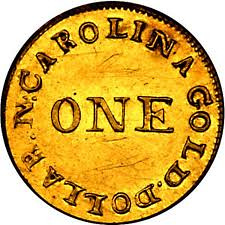 Our immediate goal and the TAF’s first project is the purchase of the Bechtler House for the community, and the continued development of it as a permanent cultural heritage center. As you must know, Christopher Bechtler, with sons Charles and Augustus, and nephew Christopher, Jr. settled in this county in 1830. The initial occupation of the German immigrant was jewelry, clock making, and gunsmithing. But his fine reputation and success, with gold and other metals, led local citizens to encourage him to assay the raw gold so easily obtained here at that time, and eventually to establish a private mint. His 1838 home is now being rented to the town and open to the public, with limited exhibits and funds.
Our immediate goal and the TAF’s first project is the purchase of the Bechtler House for the community, and the continued development of it as a permanent cultural heritage center. As you must know, Christopher Bechtler, with sons Charles and Augustus, and nephew Christopher, Jr. settled in this county in 1830. The initial occupation of the German immigrant was jewelry, clock making, and gunsmithing. But his fine reputation and success, with gold and other metals, led local citizens to encourage him to assay the raw gold so easily obtained here at that time, and eventually to establish a private mint. His 1838 home is now being rented to the town and open to the public, with limited exhibits and funds.
Our event kicks off with a VIP reception with heavy hors d’oeuvres at 4:00, by invitation only, on the grounds of the property. Following that reception, there will be a community event open to the public from 5 to 7pm. During those 2 hours there will be exhibits and tours inside the house, and a series of market and craft booths along the street.
We have on exhibit the original Bechtler coin press, on loan to us from the American Numismatic Society, NY. And for that afternoon only, we will also display the personal coin collection of our local numismatist, Norman Jenkins, whose collection of Bechtler coins alone is outstanding. There will be screenings of the recent public broadcast film “Gold Fever and the Bechtler Mint”, as well as DVD copies for sale. Entertainment on the Bechtler porch will include local bluegrass musicians, storytelling, and a gold panning demonstration.
We hope to gather dignitaries from the local to state levels, as well as local donors and various media. We would also sincerely like to solicit any donation on behalf of your organization or any of its members. It is a handsome early American house, in need of permanent maintenance and museum quality exhibits. We are very proud of what we have thus far accomplished, and have great hopes for its future. Please consider contributing to this important part of American numismatic history.
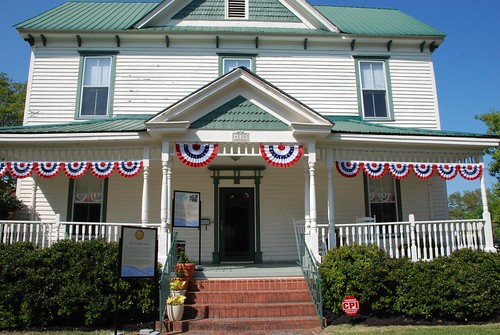
The house is located at 130 Sixth St., Rutherfordton, NC 28139. We are within 60-90 minutes from airports in Charlotte and Asheville, NC, and Greenville-Spartanburg, SC.
For more information, see: www.visitncgold.com
ARTICLE PROFILES VICTORIA CROSS COLLECTOR LORD ASHROFT
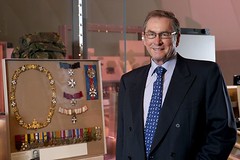 Billionaire Lord Ashcroft owns the world’s largest collection of Victoria Crosses – yet he doesn’t know if he has what it takes to win one, the Sunday People reports.
Billionaire Lord Ashcroft owns the world’s largest collection of Victoria Crosses – yet he doesn’t know if he has what it takes to win one, the Sunday People reports.
“I’ve often reflected on it,” he says. “And I’m not sure whether I have that kind of courage.”
We are in the Lord Ashcroft Gallery of London’s Imperial War Museum amid £40million worth of the most potent symbols of gallantry ever.
Building work goes on around us as the museum is revamped for next year’s centenary of the start of the First World War.
Most of the VCs on display here belong to the 67-year-old ex-deputy Tory chairman.
He owns 183 in all and gave £5million towards the gallery where, alongside the medals, the stories of supreme courage are told in words and pictures.
Stories like that of pilot Lloyd Trigg, the only man to get a posthumous VC on the say-so of the enemy after dive-bombing a U-boat when he could have pulled away to save his life.
And stories like that of Noel Chavasse, one of only three men ever to win the VC twice.
Michael Ashcroft’s interest in what constitutes courage began as a 10-year-old in Norwich when he persuaded his reticent dad to relive his experiences of D-Day, where he had been wounded.
The peer recalls: “My father was a modest man but I felt a surge of pride that he’d played such a courageous part in the war effort.
“And the most special thing about VC winners is their modesty and their humility.
“Most of those I’ve met say they only did what anyone else would have done in the same circumstances.”
The former deputy chairman of the Tory party has spent a lot of time over the years thinking about the nature of bravery.
He says. “You can’t measure it, you can’t bottle it and you can’t buy it.”
But he believes the kind of valour the VC is awarded for falls into two categories.
The first is spur-of-the-moment bravery in the heat of battle – the second, the “cold courage” needed to defuse a bomb or to go out on a special forces’ mission.
Lord Ashcroft says: “I have nothing but admiration for both – but a greater respect for ‘cold courage’ because they go into highly dangerous situations time and again knowing they are likely to get maimed or killed.”
His passion for the VC began when he was in his 20s and he read about one of the medals being sold at auction.
He promised himself he would own one as well – if he could ever afford it.
That day came in July 1986 when the VC won by diver James Magennis – whose story is detailed on the left – was auctioned at Sotheby’s. Lord Ashcroft paid £29,000 for it.
He says: “As I was holding it, it dawned on me this was just the start of owning more.
“One became two. Soon the collection hit double figures.”
Since then he has bought many more at auctions.
He also gets VCs from the families of medal-winners in private deals – but only if they approach him. Now he owns the first VC awarded in the 20th century and the last – which was posthumously earned in the Falklands conflict by Sgt Ian McKay, whose story is also told on the left.
Only 1,360 VCs have ever been handed out since the medal – cast from the bronze of cannons captured during the Crimean War – was inaugurated in 1856.
And by buying up so many, the peer has stopped large numbers of them ending up with collectors overseas.
And he has vowed to present them to the nation one day.
To read the complete article, see: Lord Ashcroft owns world's largest Victoria Cross collection - but doesn't know if he'd have courage to win one (www.mirror.co.uk/news/uk-news/lord-ashcroft-owns-worlds-largest-2365416)
THE BOOK BAZARRE
CHILD COAL-MINE HERO'S RSPCA MEDAL TO BE SOLD
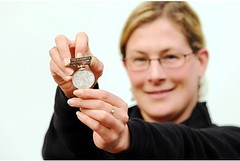 A RARE medal awarded after a young boy died trying to save his pony down a coal mine is up for auction.
A RARE medal awarded after a young boy died trying to save his pony down a coal mine is up for auction.
The silver RSPCA Posthumous Gallantry Award was given to Ernest Barnett's family in 1919 after the 14-year-old died in Williamthorpe colliery, in Holmewood, North East Derbyshire, for animal life-saving.
The young boy, who worked as a pony driver, had experienced difficulty when he was leading his pony up an incline in the colliery and, in trying to save the animal, Ernest died.
Steven Iredale, an auctioneer, valuer and cataloguer at Bamfords, where the item will be up for sale later this week, said he had never seen a posthumous RSPCA medal before.
"It is chilling to think that children as young as this were working down mines in very basic conditions here in Derbyshire less than a century ago, and could be involved such horrific accidents. He would have been a year nine pupil today.
"It is even more moving to think that his final thoughts were for his pony rather than himself."
To read the complete article, see: Medal of child coal-mine hero goes under hammer (www.thisisderbyshire.co.uk/Medal-child-coal-hero-goes-hammer/story-19901692-detail/story.html#axzz2hdAWvNUL)
IS A PHD MANDATORY FOR NUMISMATIC CURATORS?
I'm not saying it should be taken with a grain of salt, but I doubt it is an absolute requirement. At one time --post Henry Grunthal-- it was. Robert Hoge is not a PhD; in his long tenure as an ANS curator, who complained about his academic bona fides?
As the editor suggests, there could well be E-Sylum readers who would make credible candidates. There may also be readers who could spread the word about the open position to some wonderful potential candidates, with and without the preferred grad-school heft..
I do believe the rigorous academic grounding that goes with earning a PhD is a considerable asset in carrying out the duties of the position, and an asset to the Society, in carrying out its mission and in securing its prestige. The ANS has a history of hiring young PhDs with fairly slender numismatic backgrounds, compared to, say. a good dealer at a major coin show. I think the results have been very good, indeed.
All this said, I still hope that well-qualified but under-sheep-skinned persons will come forward and consider this position. Even an "unsuccessful" applicant aids the Society, if s/he deepens the pool of candidates, and the process itself could initiate a long and useful relationship between the ANS and the scholar.
To read the earlier E-Sylum article, see: ANS SEEKS ASSISTANT CURATOR OF AMERICAN COINS AND CURRENCY (www.coinbooks.org/esylum_v16n41a21.html)
MORE QUESTIONS ON THE COIN COLLECTORS KLINE
Regarding our recent discussions of dealer John W. Kline and A.C. Kline, Dan Hamelberg writes:
....and the numismatic "Kline" puzzle goes on. I can verify Joel Orosz's copy of the Winslow Howard purchase list from the June 1855 Sale. I have a priced and named copy of the sale, and the lot numbers match up with Howard's name on all the listed lots. My copy belonged to "Ammi Brown," and he was a major buyer at the sale. Other buyers of note include Bushnell, Colburn, and Mickley.
But before the "puzzle" reveals clarity, it might be helpful to get the spelling of the name correct. As John Lupia points out, the July 1866 issue of the American Journal of Numismatics (Vol. #1, #4) contains the first installment of Daniel Parish Jr's list of catalogues of coin sales. Item #15 is the Thomas & Son's June 12/13, 1855 sale. Mr. Lupia refers to it as the F. J. Kline sale, and Parish lists it as the F. J. Klein sale. Did Parish misspell the name?
Interestingly, Attinelli has a bio for both Kline and Klein. Bangs conducted a sale on October 24, 1860 featuring the collection of Francis Joseph Klein. The short bio that follows the listed sale does not match up well with the "Kline" profile associated with the 1855 sale. Nevertheless, Parish associated F. J. Klein with the sale and listed it as such.
Attinelli has a short bio for J. (John) W. Kline on page 60 of Numisgraphics, and the Kline described there is associated with the June 1855 sale. Then, of course, we have A. C. Kline listed in Attinelli for the actual sale listing in 1855.
There is strong evidence that Daniel Parish Jr. was Attinelli's "unknown" and unnamed source for many of the listings in Numisgraphics including the rare 1828 Watkins sale (more on this at a future date). So how is it that Parish associated F. J. Klein with the 1855 sale in his list published in the AJN? Is A. C. Kline really J. W. Kline? How did F. J. Klein get into the mix? A.C., J.W., F. J., will the real Kline/Klein please step forward!
To read the complete article, see: MORE RESEARCH ON THE COIN COLLECTORS KLINE (www.coinbooks.org/esylum_v16n41a14.html)
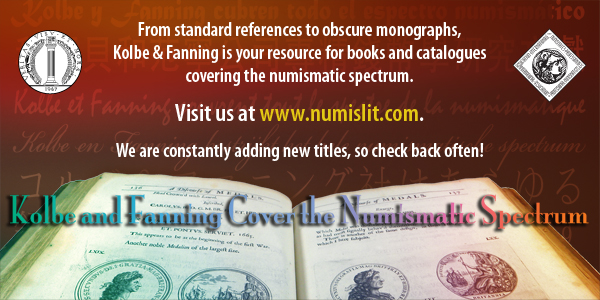
BLOG PROFILES COIN DESIGNER CHISTOPHER IRONSIDE
It’s been an exciting week for everyone here at The Royal Mint, and fans of the coins we are proud to make. Not only did we announce the design for the new coins that celebrate the christening of Prince George of Cambridge, but we were also delighted to host the BBC One Show on Monday evening.
They were here to broadcast live from The Royal Mint as we pushed the button to start production of a new 2013-dated 50 pence piece that is going into circulation to commemorate the centenary of Christopher Ironside. Born in 1913, he was the man who designed the new coins that were introduced when our coinage went decimal back in 1971.
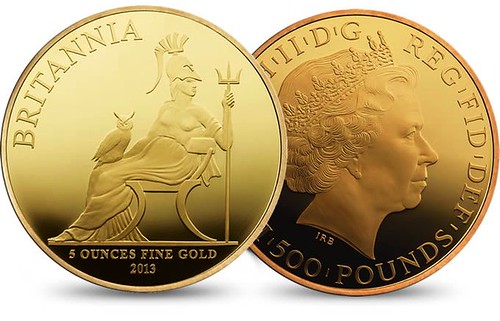
It was a very special occasion, as our guest of honour was none other than Mrs. Jean Ironside, Christopher’s widow. She was able to catch the first coin off the press, which we placed in a capsule and presented to her as a very personal memento.
The new 2013 50p features Christopher Ironside’s Royal Arms design, which was the runner-up to his winning Britannia for the first 50p produced in 1969. To celebrate his centenary, the Royal Arms design now appears on a circulating coin for the first time since its creation some 44 years ago.
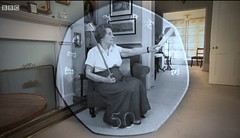 Earlier in the show, they ran a fascinating piece on the story behind Christopher Ironside’s designs for the decimal coinage, and the role that Jean Ironside played in the design of a female British icon. To help her husband create the familiar depiction of Britannia that graced the 50p piece for years to come and can still be found in our pockets today, Mrs Ironside herself posed as Britannia, using a ruler as the trident!
Earlier in the show, they ran a fascinating piece on the story behind Christopher Ironside’s designs for the decimal coinage, and the role that Jean Ironside played in the design of a female British icon. To help her husband create the familiar depiction of Britannia that graced the 50p piece for years to come and can still be found in our pockets today, Mrs Ironside herself posed as Britannia, using a ruler as the trident!
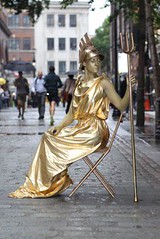 We set up some human statues in various locations around the UK, in the pose that can be seen on the 2013 Britannia proof range.
We set up some human statues in various locations around the UK, in the pose that can be seen on the 2013 Britannia proof range.
To read the complete article, see:
Revealing the secrets of Ironside’s decimal coin designs
(blog.royalmint.com/fascinating-story-behind-british-icon/)
BLACKFRIARS BRIDGE AND HOLBORN VIADUCT MEDAL
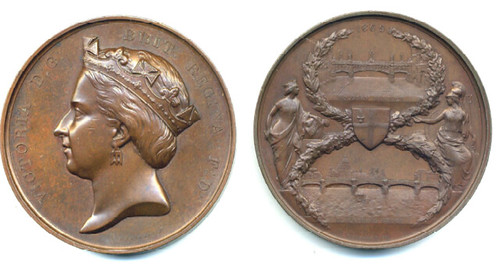

OPENING OF BLACKFRIARS BRIDGE AND HOLBORN VIADUCT, 1869. – A CASED PAIR. BHM 2906; Eimer 1604; Welch 11. 77mm. Bronze. G.G. Adams, Sc. Both medals are uncirculated although one has a few very minor contact marks on the Queen’s cheek.
Obverse: Diademed head of Victoria, left. Rev: Views of the Bridge and Viaduct with two wreath flanked by the arms of London.
BHM 2906, Welch 11, Eimer 1604. 400 specimens struck. Cased pair of medals in an original 8 x 4 !” double case with the city arms and a 14 line gilt inscription on the top of the box. The case has seen moderate wear and does not close completely. A total of 400 medals were struck. $750.00
1604 HENRY IIII MEDAL INFORMATION SOUGHT
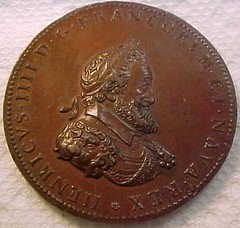
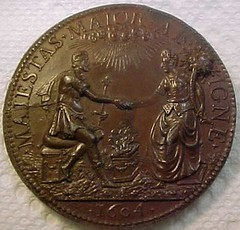
Michael Sanders writes:
This 1604 Henry IIII medal is way beyond my area of expertise. I'm wondering if any of your readers could shed some light on the history of this medal. Possibly someone could direct me to a reference and advise me of the scarcity of this piece. It is 57 mm in diameter and has the ring (or lack thereof) of base metal. As you can see, the bronze plating is wonderfully intact.
SILVERDALE VIKING COIN HOARD TO BE DISPLAYED
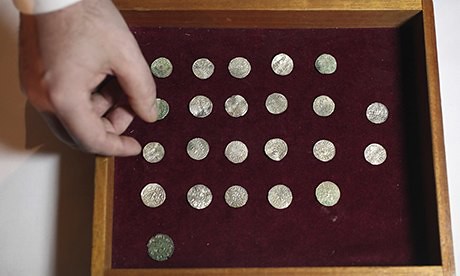
A spectacular stash of Viking treasure – more than 200 pieces of silver including beautiful arm rings, brooches, silver ingots, and a battered, misspelt coin that revealed a previously unknown Viking ruler – will go on display this month near where it was found by a metal-detector enthusiast two years ago.
The hoard was found packed into a lead container inches below the surface of a field in Lancashire. But whether it would be displayed in the county where it was found had seemed in doubt in the economic climate.
Now, though, Lancashire county museum service has raised the £110,000 that it needed to acquire the third-largest Viking hoard found in the UK, with the help of a £45,000 grant from the National Heritage Memorial Fund, £33,000 from the Art Fund charity, plus other grants and local donations.
Dozens of coins dated the hoard to about AD900, and also demonstrated the breadth of the Viking world, including Anglo-Saxon and Scandinavian, Frankish and Islamic examples. The rarest – with a cross dating it to the time when the Vikings adopted the powerful new god of the Christians – bears the name Airdeconut, believed to be an attempt at the Scandinavian Harthacnut, a previously unrecorded ruler. There was also a coin minted for the nephew of Alfred the Great, and a fake coin with a thin film of silver over copper.
Dame Jenny Abramsky, chair of the memorial fund, said: "The Silverdale hoard offers a unique window into the lives and craftsmanship of the Vikings who inhabited Lancashire over 1,000 years ago. The fund exists to make sure historic gems such as this are not lost from this country and so our trustees felt it was vital it should be saved for future generations to learn from and enjoy."
To read the complete article, see: Silverdale Viking treasure to go on display in Lancashire (www.theguardian.com/culture/2013/oct/11/silverdale-viking-treasure-display-lancashire)
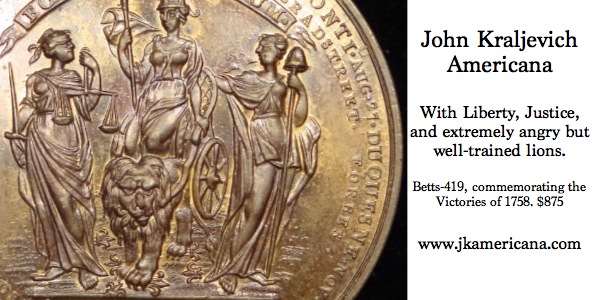
QUERY: INFORMATION ON FLUSSGOLDDUKATEN SOUGHT
Dick Hanscom writes:
I was reading the Q&A column in World Coin News and the question was “What are flussgolddukaten?”
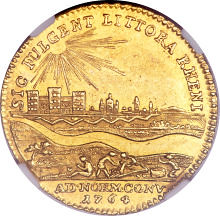 I loved the answer – ducats made from gold from specific rivers in Germany. I particularly like the attached coin, as it shows miners on the bank of the river. Since this is kind of sort of what I do with Alaska placer gold, I found it fascinating.
I loved the answer – ducats made from gold from specific rivers in Germany. I particularly like the attached coin, as it shows miners on the bank of the river. Since this is kind of sort of what I do with Alaska placer gold, I found it fascinating.
I have scoured the internet for information, but was wondering if there is a website dedicated to these coins, or perhaps a publication.
There are still people in Germany placer mining the sands of the Rhine, and making gold tokens!
I would like to include information on these coins in the 5th edition of my book “Striking Gold in Alaska, Making Tokens from Placer Gold.” This would replace the chapter in the 4th edition on the Veld Pond.

Rare U.S. & Worldwide Banknotes, Scripophily and Autographs
“The Copps Collection” of Colonial Stocks, Bonds, Documents & Fiscal Paper to be held in conjunction with the 3rd Annual Wall Street Coin, Currency & Collectibles Show.
Highlights include:
- From “The Copps Collection”, A 1792 U.S. Federal Bond Issued to and Signed by George Washington, this is one of three known, the other two are in an institutions, this is the first time ever at auction
- U.S. Colonial; Obsolete; Fractional; and, Large Type Notes including a high grade “Educational” Set of 3 notes along with dozens of other rare banknotes.
- Worldwide Banknotes including an outstanding U.A.E. Specimen Set as well as hundreds of other rare and desirable notes.
- Hundreds of U.S. & Worldwide Stocks and bonds including autographed certificates and autographs by Daniel Drew; Thomas Edison; Buffalo Bill Cody, Robert Morris and many others.

1580 Lemoine Avenue, Suite #7
Fort Lee, NJ 07024
Phone: 201-944-4800
Email: info@archivesinternational.com
WWW.ARCHIVESINTERNATIONAL.COM
THE USE OF CHINESE COINS IN BALI
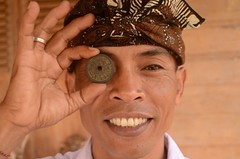 Sometimes history is written in monumental remains of the past, such as Borobudur or Prambanan. Sometimes history is written in a less-than-monumental manner, which, although tiny, can also hold extraordinary tales.
Sometimes history is written in monumental remains of the past, such as Borobudur or Prambanan. Sometimes history is written in a less-than-monumental manner, which, although tiny, can also hold extraordinary tales.
For one volunteer with the Denpasar office of archeology, I Dewa Nyoman Putra Harthawan, ancient coins found across Bali can tell unexpected stories about the island’s earliest civilizations.
A coin collector and lecturer on the archeology of currency at Udayana University, exhibited his coin collection during a recent puppet festival at the House of Masks and Puppets in Kubu Bingin.
He says that one of his coins provides evidence of a millennia-old relationship between Bali and China.
“My oldest coin is a Chinese copper coin from 175 BC. This small coin has a huge story, not only because it proves that there was ancient trade with China, but because these coins have become part of our culture.”
“This coin is known as a ban liang, or half liang, from the Han dynasty,” Dewa says. “From these remains, we have good evidence that we have had contact with China since very early on [….] We have found not just one of these coins, but many coins from an era 2,000 years ago. We have had intensive contact with China for more than two millennia.”
People in Bali used Chinese and Dutch coins from ancient times throughout the Dutch colonial occupation all the way until Independence, Dewa said. “Up to the 1950s, Bali had two currencies — Dutch and Chinese coinage simultaneously, but holding different values, much like the rupiah against the dollar today.”
Artisans of these former eras have also left their mark, with many coins bearing symbols specific to Indonesian culture and beliefs, rather than Chinese characters.
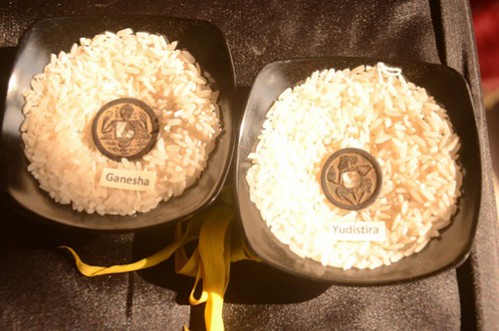
Dewa’s collection features many coins, some tarnished and black, others defaced with the original Chinese characters removed and re-etched with symbols of wayang puppets, horses and elephants.
“The removal of Chinese characters is a big mystery,” Dewa says. “This may have been done between the 15th and 17th centuries, with the inspiration to alter the coins influenced by the Majapahit period. There is an Indian influence to the coins that is quite different from their original Chinese characters.”
The introduction of symbols from Hindu epics such as the Mahabharata has echoed through the centuries, with Balinese still using Chinese coins as offerings in religious ceremonies.
To read the complete article, see: History etched in ancient copper (www.thejakartapost.com/news/2013/10/10/history-etched-ancient-copper.html)
BANK OF CEYLON PLANS NEW MUSEUM IN 2014
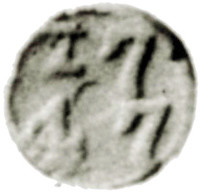 Coins started to be used for trade from around 500 BCE, and have been collected ever since. The oldest coin collection in Sri Lanka is that of the Colombo National Museum. There are also smaller collections on display in many of the provincial museums run by the National Museums and the Archaeology Department. Many vihares also have displayed coins that have been gifted to them over many generations, like at Colombo’s Gangarama temple where there are coins, most often displayed in basins with no numismatic classification or information.
Coins started to be used for trade from around 500 BCE, and have been collected ever since. The oldest coin collection in Sri Lanka is that of the Colombo National Museum. There are also smaller collections on display in many of the provincial museums run by the National Museums and the Archaeology Department. Many vihares also have displayed coins that have been gifted to them over many generations, like at Colombo’s Gangarama temple where there are coins, most often displayed in basins with no numismatic classification or information.
Coins are some of the oldest positively dateable items that can be collected. The public is allowed legally to own ancient coins, but any over a hundred years old are considered as antiques and cannot be exported.
Recently I had the opportunity to look at the coins confiscated by the Sri Lanka Customs Department- among them, coins less than 100 years old. Apparently, the whole collection is confiscated if any antiques are detected. There were also many obviously modern replicas. The Customs and even the Archaeology Department do not appear to have the competence to recognize them, or the genuine coins have mysteriously transformed to replicas over some years of storage.
The Customs Department is now constructing a small museum of confiscated items, at their new headquarters in Colombo Fort. It is a pity that this Customs museum is not being set up at the Bandaranaike International Airport in Katunayake that would have been a far better venue to act as a deterrent to illegal export. If within the departure and transit area, it could also serve as an opportunity to educate passengers awaiting their flights of our culture and heritage.
The security of a collection is always a concern. Some of the most important and invaluable coins of the Colombo National Museum collection were stolen in the robbery on March 16, 2012. The rare Ada Kahavanu of which only five specimens are known is an irreplaceable loss.
Many local banks have, time and again put coins and currency on display. However, most of these museums have now been closed mainly due to the lack of funds or interest. The museums at the National Savings Bank and the Peoples Bank are examples. There is a small collection in the Hatton Nation Bank headquarters, which opened few years ago which is not well publicized.
The Bank of Ceylon (BoC) opened a museum in 1989 for their 50th Anniversary, which included a collection of coins and currency loaned by Fred Medis. Around 2002 this collection moved from Bristol Street to the 28th floor of the BoC Tower and since then can be seen only by prior arrangement.
A new and larger BoC museum is being planned to be opened in time for their 75th Anniversary in 2014 in active consultation with the Sri Lanka Numismatic Society (SLNS), and coordinated by a museologist. This will hopefully prevent the errors seen at other locations. BoC hopes to keep this museum open to the public, and have a small lecture hall and archival area to promote the study of numismatics. Located on the 28th floor of the BoC Tower, which also has an open balcony with a breathtaking view of the Colombo City and harbour, it will surely become a popular destination for both schoolchildren and tourists. (The writer maintains an educational website on Lankan coins at http://coins.lakdiva.org , and is President of the SLNS.)
To read the complete article, see: Taking count of ancient coins (www.sundaytimes.lk/131013/plus/taking-count-of-ancient-coins-65301.html)
THE BOOK BAZARRE
PRINCE GEORGE'S £50,000 GOLD COIN
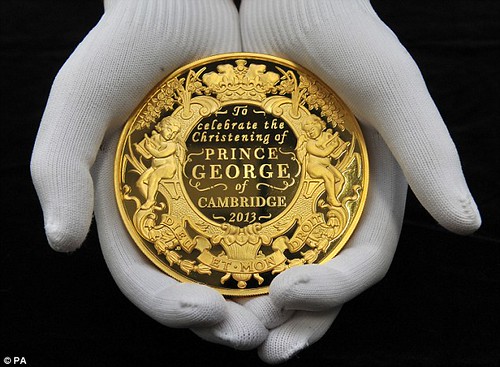
The Duke and Duchess of Cambridge have given their approval to the first ever royal christening coins created in the UK.
The special coins, which have been produced by the Royal Mint in Llantrisant, South Wales, go on sale today to mark the christening of the couple's son, Prince George.
The design features the Lily Font from the Tower of London and two harp-playing cherubs.
At the foot of the coin is the royal motto "Dieu et mon droit" - God and my right.
The £5 coin is available in silver - because the crossing of a baby's palm with silver is said to confer good health and prosperity to newborns - and gold - to commemorate the royal celebration.
William and Kate's son will be christened at the Chapel Royal, St James's Palace on October 23.
Dr Kevin Clancy, director of the Royal Mint Museum, said: "I think the designer, John Bergdahl, has done an excellent job of giving us something that is timeless. It's symbolic and it's got dignity about it.
Mr Bergdahl said: "The design is baroque, a style that has been reborn many times and often featured in royal artwork and traditions.
"One element that I knew I wanted to incorporate was the Lily Font from the Tower of London, which is a strong tradition in christenings for the Royal Family.
"The motto is traditional and sums up the expectation carried by a young child, born to reign - regardless of gender - for the first time ever."
Mr Bergdahl said it normally takes up to two years to produce a new coin, but the christening edition had to be made in around seven months because of the unknown details about the royal baby, such as its gender or name.
"Hopefully it will be timeless and it will still look as good in 100 years' time as it does now," he added.
The limited edition gold "kilo coin" is being sold for £50,000 but a more affordable "Brilliant Uncirculated" coin costs £13.
To read the complete article, see: Prince George's £50,000 coin: Piece containing 1kg of gold among first set minted to commemorate a royal christening (www.dailymail.co.uk/news/article-2449228/Prince-Georges-50-000-coin-Piece-containing-1kg-gold-set-minted-commemorate-royal-christening.html)
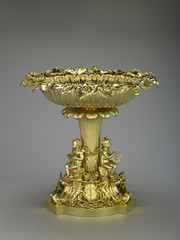 Charles II not only had made a whole set of regalia in 1661, he had a whole gold altar set made for Westminster Abbey, plus an enormous solid gold dinnerware set for the coronation banquet. The altar set included a gold chalice (cup) and paten (plate) for the Holy Communion, plus a baptismal font that was used for the christening of every royal baby for 180 years. In 1840 Queen Victoria commissioned the silver-gilt Lily Font for her first child, Princess Victoria (later the Empress of Germany), which has been used ever since.
Charles II not only had made a whole set of regalia in 1661, he had a whole gold altar set made for Westminster Abbey, plus an enormous solid gold dinnerware set for the coronation banquet. The altar set included a gold chalice (cup) and paten (plate) for the Holy Communion, plus a baptismal font that was used for the christening of every royal baby for 180 years. In 1840 Queen Victoria commissioned the silver-gilt Lily Font for her first child, Princess Victoria (later the Empress of Germany), which has been used ever since.
To read the complete article, see: The British Crown Jewels (jeremyturcotte.wordpress.com/2013/09/06/the-british-crown-jewels/)
VATICAN MEDAL MISSPELLS NAME OF JESUS
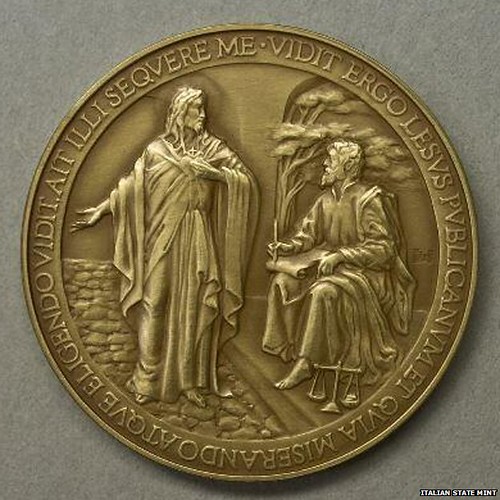
Bill Rosenblum, Alan Luedeking and Arthur Shippee forwarded this article from BBC News:
The Vatican has withdrawn from sale 6,000 copies of a new papal medal on which the name of Jesus was misspelt.
In an inscription around the edge of the coin, Jesus was mistakenly spelt with an L.
Keen-eyed experts snapped up a handful of the coins, which were struck in gold, silver and bronze by the Italian mint, before the mistake was noticed.
Vatican coins and medals bearing the face of Pope Francis are bought by collectors all over the world.
A few collectors may make a fortune because of the scarcity value of the flawed medals, the BBC's David Willey reports from Rome.
New medals are struck when every new pope is elected and they provide a useful source of income for the Vatican, which is undergoing a major spending review under the leadership of Pope Francis, our correspondent says.
As news of the mistake travelled, social media users cracked jokes about this new religious figure, "Lesus" Christ. "I blame the Lesuits," went one tweet while another had "Let us prey Lesus".
To read the complete article, see: Vatican pulls papal medal which misspelt name of Jesus (www.bbc.co.uk/news/world-europe-24489512)
From a CNN article forwarded by Anne Bentley:
For the love of "Lesus," the Vatican needs a copy editor -- preferably an infallible one.
But when the Vatican drew up the medal, it flubbed the Latin phrase, said spokesman the Rev. Federico Lombardi. (It's worth noting that Latin doesn't have a "J," so maybe we should cut the Vatican a bit of slack.)
Lombardi said the Vatican is to blame for the mishap, saying the error was made "in the preparation, not the execution."
The Italian Minting Institute made about 6,000 of the "Lesus" medals and retrieved all but three or four, according to media reports, which means a few folks are holding onto some pretty valuable mistakes.
To read the complete article, see: Vatican pulls misspelled 'Lesus' coins (www.wcvb.com/Vatican-pulls-misspelled-Lesus-coins/-/9849586/22387320/-/ove7m6/-/index.html)
Dick Hanscom forwarded an article fro The Daily Mail with a closeup image of the mistake. Thanks.
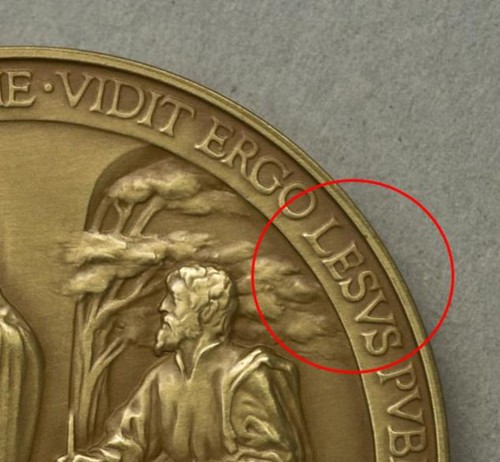
To read the complete article, see: Heaven and L: Vatican release medal to commemorate the first year of Pope Francis’s reign… but spells Jesus LESUS (www.dailymail.co.uk/news/article-2452579/Vatican-misspelled-Jesus-commemorative-medal-Pope-Franciss-reign.html)
BEP RELEASES NEW 2013 $100 BILL
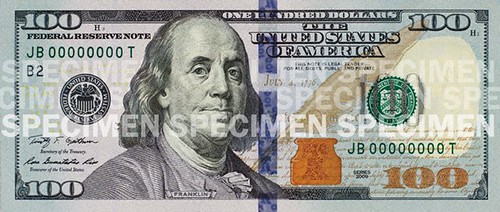
With the fanfare of a hard cough, the Federal Reserve released the new $100 Federal Reserve Note on Tuesday, October 8, 2013 to financial institutions. Various factors will affect how quickly these notes are seen in circulation including the demand and ordering policy of the financial institutions. In fact, the launch was introduced with a video by Sonja Danburg, Program Manager of the U.S. Currency Education Program at the Federal Reserve.
This launch is three years in the making as Bureau of Engraving and Printing reported problems with folding during the printing of the new notes. The announcement on April 21, 2010 said that the new notes would be released on February 10, 2011. On October 1, 2010, the Federal Reserve announced that the new note would be delayed. Later, the folding problems were revealed following a report released by the Treasury Office of the Inspector General.
The reason for the new notes are for the addition of security features. Aside from the ecurity thread, portrait watermark, color-shifting ink, microprinting, and the strategic use of color, the new note has a 3-D security ribbon and the use of color-shifting ink used to reveal a bell in the inkwell. If you look at the blue ribbon on the front of the note, tilt the note and watch the bells on the ribbon change to “100s” as the reflection of light changes. The 3-D ribbon is embedded in the paper and not printed. Looking at the copper-colored inkwell on the front of the note, tilting the note will reveal a bell that was embedded using color-shifting ink. Using these light sensitive features, the Federal Reserve hopes to significantly reduce the number of counterfeit notes, especially overseas where half of the $100 notes are known to circulate.
The Federal Reserve released a video about the new anti-counterfeiting features.
To read the complete article, see: http://coinsblog.ws/2013/10/new-100-bills-released.html (coinsblog.ws/2013/10/new-100-bills-released.html)

BANK OF ENGLAND'S BANKNOTE DESIGN DECISION PROCESS REVEALED
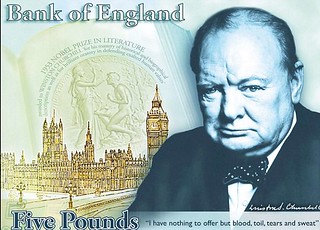 Bank of England bosses thought twice about putting Sir Winston Churchill on the new £5 note – because they didn’t want to upset the Germans.
Bank of England bosses thought twice about putting Sir Winston Churchill on the new £5 note – because they didn’t want to upset the Germans.
Officials warned Sir Mervyn King, then Governor of the Bank of England, that Churchill’s wartime record might make him highly controversial, documents obtained by The Mail on Sunday show.
The same officials also insisted on carrying out a background check on Jane Austen, the prim spinster author of Pride And Prejudice who will appear on the £10 note from 2017, to reassure themselves there were ‘no issues in her private life’.
Previously classified documents, obtained under freedom of information laws, shed light on the hitherto secret process of how the Bank of England decides which historic figures are honoured.
In a memo dated April 11, 2012, Sir Mervyn was advised Churchill will be a popular choice because of his ‘broad name recognition’ and the public’s ‘very affectionate view’ of him as a wartime leader. But officials also warned him that ‘the recentness of World War II is a living memory for many here and on the Continent’.
The rest of the comments, which relate to Britain’s relationship with its former wartime enemies, have been redacted from the files.
Maureen Stiller, of the Jane Austen Society, said: ‘I love the fact they went to the trouble of checking her private life. But there is absolutely no controversy there.’
Churchill will appear on the £5 note from 2016. A Bank spokesman said: ‘We have taken great care to ensure men and women chosen are admired by the British public.’
To read the complete article, see: Bank nearly banned new £5 note with Churchill on it in case it upset the Germans...and officials worried about Jane Austen 'private life' (www.dailymail.co.uk/news/article-2456335/Bank-nearly-banned-new-5-note-Churchill-case-upset-Germans--officials-worried-Jane-Austen-private-life.html)
A BIRTHDAY CAKE MADE OF DOLLARS
One of my nieces, Tu, in Viet Nam sent me the attached image of a birthday cake made of US$ notes. This is the first time I have seen anything like it, and maybe some of your readers would enjoy seeing it too! Best regards, Howard
ARTISTS FORMS GEOMETRIC SCULPTURES FROM INTERLOCKED COINS
Bob Fritsch writes:
I got this site from an elongated coin discussion group, and thought E-Sylum readers would enjoy it.
 When artist Robert Wechsler comes across a large number of coins, he doesn't just trade them in for dollar bills like everybody else. Instead, he sees an opportunity for art. Using quarters, dimes, and pennies, Wechsler recently developed this series of complex geometric forms, simply called Money, as a commission for The New Yorker's October 14, 2013 money-themed issue.
When artist Robert Wechsler comes across a large number of coins, he doesn't just trade them in for dollar bills like everybody else. Instead, he sees an opportunity for art. Using quarters, dimes, and pennies, Wechsler recently developed this series of complex geometric forms, simply called Money, as a commission for The New Yorker's October 14, 2013 money-themed issue.
Whether electronic or material, we all use currency on a daily basis. Through his work, Wechsler invites us to look at the highly valued metal and paper forms with a different perspective. From fresh, shiny, and new, to aged and completely worn, Wechsler uses not just US currency, but also coins from places including Canada, Belize, and Hong Kong. He carefully cuts notches into each coin and manually joins them together to create the fascinating variety of shapes and patterns.
In all of his art, the artist reworks objects and shapes into creative shapes and structures, and he says, "My work seeks to awaken undiscovered virtue in everyday objects and spaces by challenging commonplace associations through careful intervention."
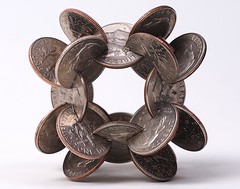
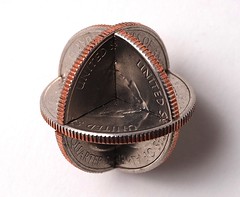
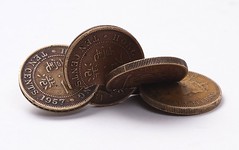
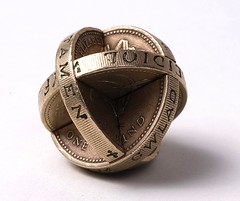
To read the complete article, see: Interlocked Coins Form Complex Geometric Sculptures (www.mymodernmet.com/profiles/blogs/robert-wechsler-money-coin-sculptures)
FEATURED WEB PAGE: VISIT N.C .GOLD
This week's Featured Web Page is VisitNCGOld.com, the home of the Tourism Asset Foundation of Rutherford County, NC.The TAF is a non-profit organization with the mission of developing permanent and tangible tourism assets as they relate to history, heritage, agritourism, outdoor recreation and local culture in Rutherford County, NC. The first task of the TAF is to secure grant funding and raise money from private donors to purchase the Bechtler House, and then to develop the Bechtler Mint Site.
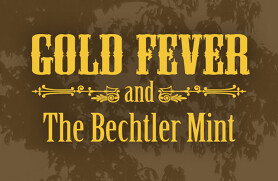
www.visitncgold.com

